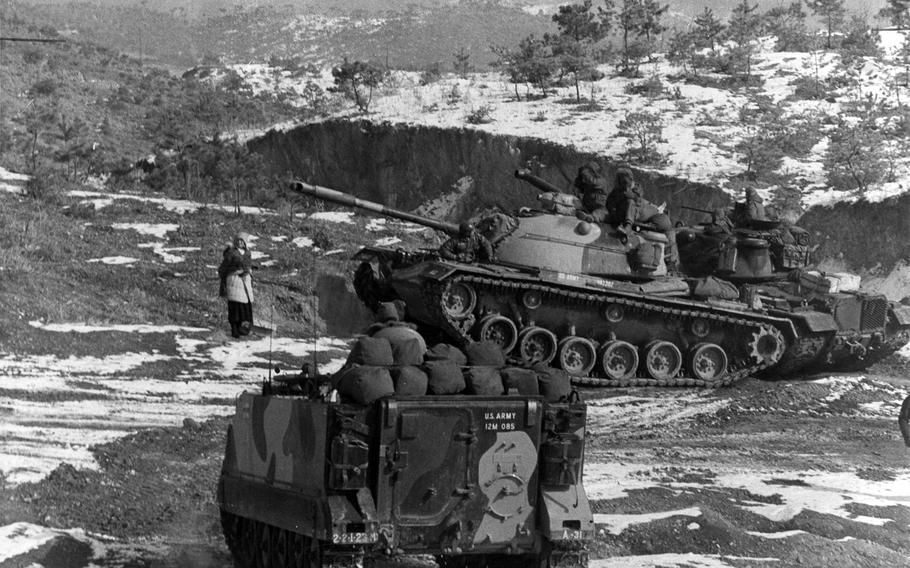
A woman pauses to watch personnel carriers and tanks from the 2nd Battalion, 23rd Infantry Regiment and 1st Battalion, 72nd Armored Regiment that were participating in an exercise on Korea's western front on Dec. 23, 1966. On July 2, 2015, units belonging to the 2nd Infantry Division's 1st Brigade Combat Team will inactivate, marking the end of more than 50 years on the peninsula. (Stars and Stripes file photo)
SEOUL, South Korea — A unit that has guarded the Korean peninsula’s tense border for five decades has been inactivated and replaced with the Army’s first rotational brigade combat team deployed to the area.
The 2nd Infantry Division’s 1st Armored Brigade Combat Team — known as the “Iron Brigade” — was inactivated Thursday morning during a ceremony at Camp Casey. Assuming its responsibilities is the Fort Hood-based 1st Calvary Division’s 2nd “Black Jack” Brigade Combat Team, which is in Area 1 on a nine-month deployment.
Military officials have touted the move to rotational deployments of units stationed along the Demilitarized Zone as a way to maintain cohesion in a theater where constant turnover is the norm. Troops are typically stationed in South Korea on one- or two-year tours. But under the rotational deployment plan, entire units will train for and deploy to the peninsula together.
“I can tell you that when this transfer of authority takes place, our amount of readiness goes up,” said Gen. Theodore Martin, 2ID commander. Having intact rotational units deploy to the division also means he won’t see a turnover of about 10 percent of his forces each month, he said.
Prior to this deployment, the Black Jack Brigade completed training at Fort Irwin’s National Training Center in California that focused on Korea-specific operations and the ability to secure weapons of mass destruction.
When the brigade completes its tour, it will be replaced by another combined-arms brigade combat team.
The Iron Brigade, headquartered in South Korea since 1965, has spent the past months preparing for the transition, and is leaving its armored personnel carriers and other tactical vehicles for the Black Jack Brigade and future rotational forces.
One of the biggest difficulties of the transition has been coordinating housing for soldiers in both brigades, Martin said. Incoming forces have also been schooled on the mission’s complexity and the operating environment on the Korean peninsula, where thousands of North Korean troops and weaponry are in close proximity to the border.
“This mission is like no other in the Army,” Martin said.
Units that cased their colors and were inactivated Thursday are the 2nd Battalion, 9th Infantry (Mechanized); the 302nd Brigade Support Battalion; 1st Battalion, 72nd Armor Regiment; 4th Squadron, 7th Calvary; and the 1st Brigade Special Troops Battalion.
The 1st Armored Brigade Combat Team’s Headquarters and Headquarters Company also cased its colors but will uncase them at Fort Lewis in Washington later in the summer.
Since 2013, the United States has sent several rotation forces to South Korea, including the 23rd Chemical Battalion, three Kiowa helicopter units and two combined-arms battalions.
June also marked the arrival of a multiple-launch rocket system battalion in South Korea. About 400 soldiers from 2nd Battalion, 20th Field Artillery Regiment, deployed from Fort Hood, Texas.
The unit is the first rotational MLRS battalion to deploy to Korea, where they joined the 210th Field Artillery Brigade at Camp Casey. The addition of 2nd Battalion, 20th Field Artillery to Korea is part of an Army-wide reorganization to increase the number of MLRS battalions in all field artillery brigades from two to three, increasing theater readiness and maneuver capabilities.
The MLRS is a mobile automatic system that fires surface-to-surface rockets from the M270 and M270A1 weapons platform. Manned by a three-man crew, the system can fire 12 MLSR rockets in less than one minute, according to the Lockheed Martin website.
The arrival of 2nd Battalion, 20th Field Artillery is “another influx of combat power,” Martin said. “It gives us really enhanced long-range artillery capability.”